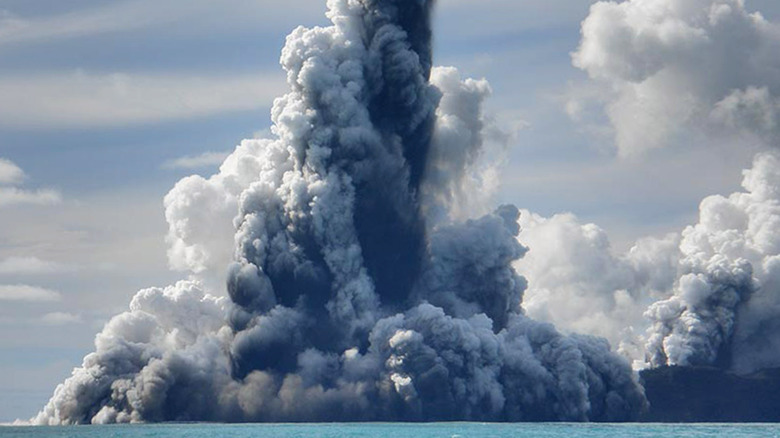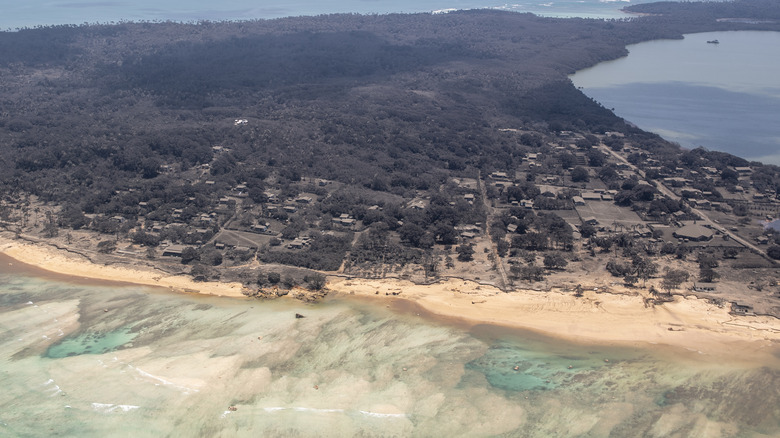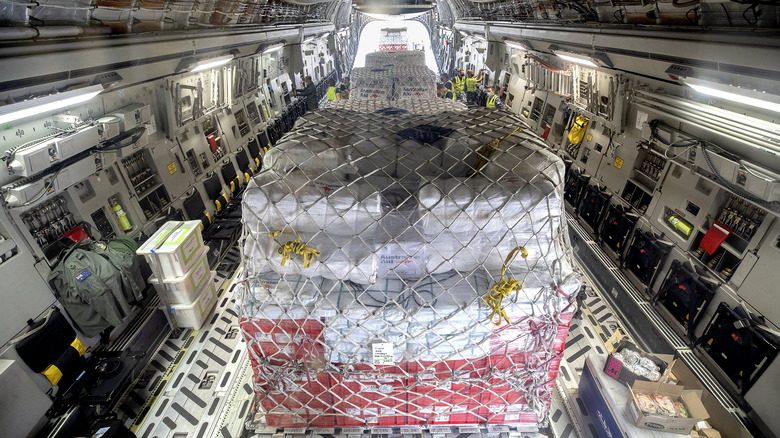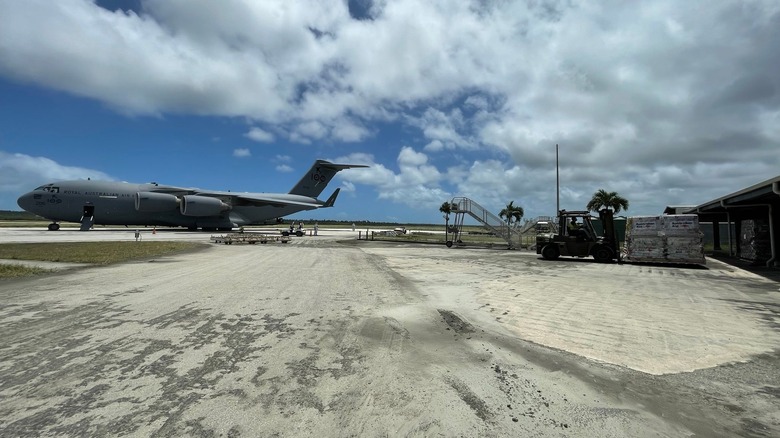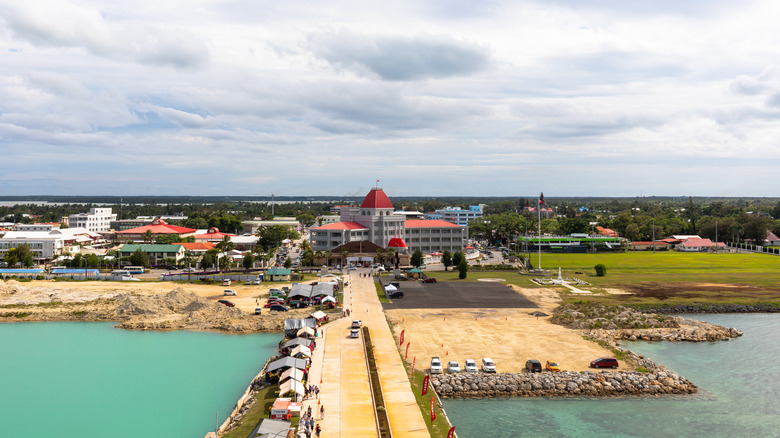NASA's Data On The Massive Tonga Volcanic Eruption Will Blow Your Mind
In January 2022, a massive volcanic eruption rocked the small Pacific island nation Tonga. Sound waves from the blast traveled as far away as Alaska, and experts believe it was the loudest event to occur on Earth in more than a century. The signs of devastation on Tonga itself were apparent as ash covered homes and buildings. The Tongan airport was also closed down and undersea lines of communication were cut. Now, satellite imagery from NASA offers new perspective on just how large the Tongan volcanic eruption truly was, according to NPR.
Prior to the 2022 explosion of the submarine volcano Hunga Tonga-Hunga Ha'apai, near Tonga, satellites had only previously captured data on one other gigantic volcanic eruption in the early 1990s at Mount Pinatubo, near the Philippines. That eruption shot ash and volcanic aerosols such as sulfur dioxide gas more than 20 miles into the atmosphere (via Britannica). According to Kristopher Bedka, an atmospheric scientist at NASA Langley, speaking with NASA's Earth Observatory website, the Tongan volcanic eruption far exceeds that — or any other event of its kind that has so far been observed from space. (A smaller underwater volcanic eruption near Tonga from 2009 is pictured above).
A tsunami was triggered
The underwater volcano Hunga Tonga-Hunga Ha'apai is located just 40 miles north of Tonga's capital city, Nuku'alofa, according to CNN, an area with some 23,000 residents, per World Population Review. In addition to thick layers of ash covering many Tongan population centers, the 2022 blast triggered a tsunami, killing three people, based on reporting from Insider. The sonic boom created by the explosion rippled around the plane twice. All homes on the remote Tongan island Mango Island were destroyed.
As NPR goes on to note, after the volcanic eruption, Tonga's more than 100,000 residents were cut off from the outside world and relief efforts for days. Hunga Tonga-Hunga Ha'apai itself is thought to have been completely destroyed by the blast, as well as parts of a nearby island. U.S. Geological Survey geophysicist Michael Poland said (via NPR), "This might be the loudest eruption since Krakatau," referencing the massive eruption of an Indonesian volcano in 1880. Of the satellite data now published in Geophysical Research Letters, study author Luis Millán added (via CNN), "We've never seen anything like it."
Japanese and American satellites captured data
As NASA's Earth Observatory website goes on to report, data gathered and analyzed in Luis Millán's study came from the National Oceanic and Atmospheric Administration (NOAA) Geostationary Operational Environmental Satellite 17, also known as GOES-17, as well as the Japanese Aerospace Exploration Agency (JAXA) satellite Himawari-8. Scientists involved in the research reached their conclusions by applying an algorithmic calculation previously used to analyze thunderstorms and other types of extreme weather events.
Crucial to the process was the ability to process data of the same event from two sets of satellite imagery. Through that synthesis of satellite data, a stereoscopic animation of sorts was created of the explosion as it happened. Measurements were then compared against NASA GEOS-5 model analysis to confirm the findings. Of the study, NASA Langley atmospheric scientist Kristopher Bedka said, "We are fortunate that it was viewed so well by our latest generation of geostationary satellites and we can use this data in innovative ways to document its evolution."
Ash from Hunga Tonga-Hunga Ha'apai nearly reached space
According to Insider, what was revealed in the study "The Hunga Tonga-Hunga Ha'apai Hydration of the Stratosphere," now published in Geophysical Research Letters, is that ash from the submarine volcanic eruption nearly reached space, with the plume of gas, ash, and aerosols triggering electric currents and hurricane-level winds in the ionosphere, near the uppermost layer of the Earth's atmosphere, reaching up to 400 miles above the planet's surface (via NASA Solar System Exploration). Of that atmosphere disturbance, NASA said in a statement that winds reached nearly 500 miles an hour, or the fastest winds ever clocked at that altitude.
Though estimates vary, the fastest hurricane-speed wind speed recorded on Earth was around 254 mph, according to Thought Co, providing some scale for how fast the upper-atmosphere Hunga Tonga-Hunga Ha'apai winds traveled. According to Space.com, the blast also affected the Earth's so-called equatorial electrojet, a current of electricity that forms a ring around the Earth's equator, causing it to surge in strength and reverse direction several times. Of the findings, NASA scientist Jim Spann said (via Space.com), "These results are an exciting look at how events on Earth can affect weather in space, in addition to space weather affecting Earth."
It was all over quickly
Also notable, though, about the underwater volcanic eruption near Tonga is that for all the devastation created, the eruption itself was relatively short when compared to other major blasts, as reported by NPR. Some major eruptions in the past have lasted for hours, but for all the fury unleashed by Hunga Tonga-Hunga Ha'apai, it was all over in less than an hour. That big impact in a small time frame is more common with on-land volcanic eruptions, as experts told the outlet, and the fact that it happened from a submarine explosion only adds to the mystery. As a scientist involved in the study said (via NPR), "[T]hat's just a head-scratcher."
In addition to ash and volcanic aerosols, what was also revealed in the Tongan study is that enough water (vapor) to fill 58,000 Olympic-sized swimming pools blasted into Earth's stratosphere, as high as 33 miles above the surface, per CNN. That amount of water vapor could temporarily warm the planet. Though expected to dissipate, excess water vapor can stay in the atmosphere for years, and lead to a number of damaging chemical reactions in Earth's protective layer. Scientists now think the depth of Hunga Tonga-Hunga Ha'apai's caldera was a contributing factor to the massive amount of water vapor created — it was the precise depth needed, about 150 feet.
The blast equaled 10 megatons of TNT
Also noted in the findings published in Geophysical Research Letters is that the plume of the volcanic eruption itself went quite high, or to the third layer of the Earth's atmosphere known as the mesosphere, some 36 miles above the Earth's surface, as Earth Observatory explains. Otherwise, the blast itself was roughly comparable to 10 megatons of TNT, or up to 500 times as powerful as the nuclear bombs dropped on Japan at the conclusion of World War II.
Scientists from NASA were aware of the Hunga Tonga-Hunga Ha'apai underwater volcano before it exploded in early 2022. The island of Tonga itself is on a subduction zone in the Earth's layers, creating the perfect condition for volcanoes, and the Tongan islands themselves were likely created by volcanic activity. Luckily, based on track records, this could be the biggest volcanic eruption for quite some time, as NASA scientist James Garvin told NPR. "If the past precedent for volcanic eruptions in this kind of setting has any meaning at all ... then we won't have another one of these explosions for a while," Garvin said.
